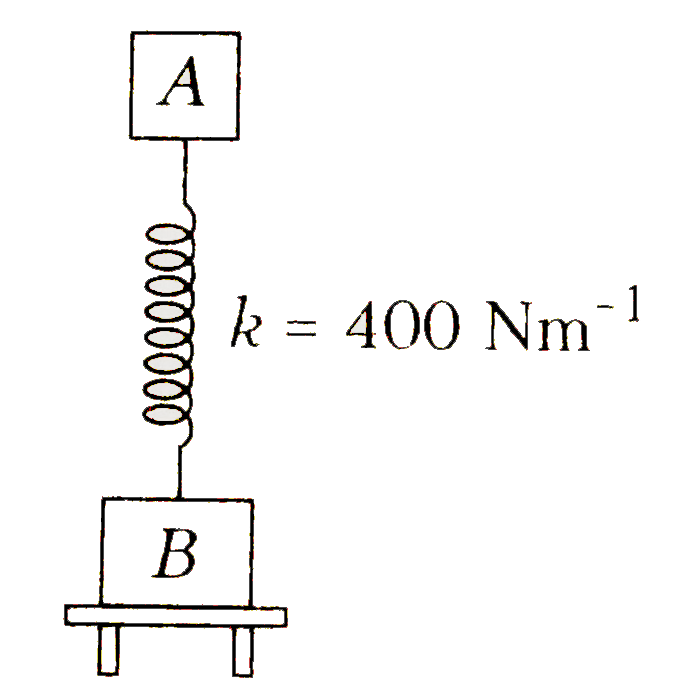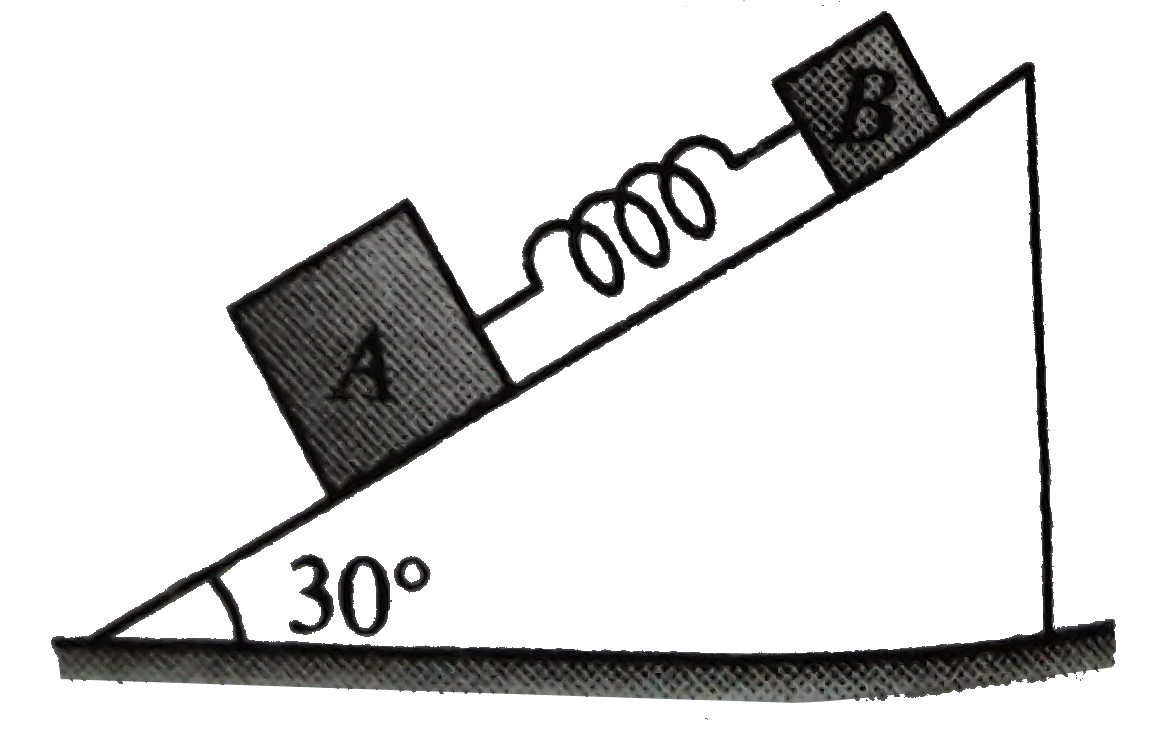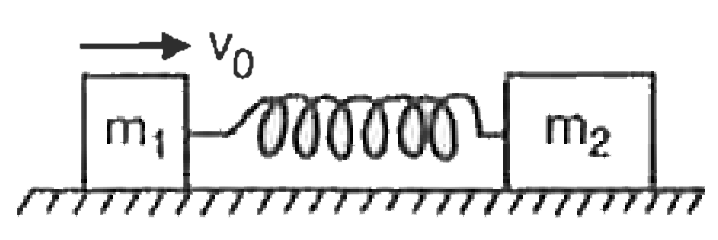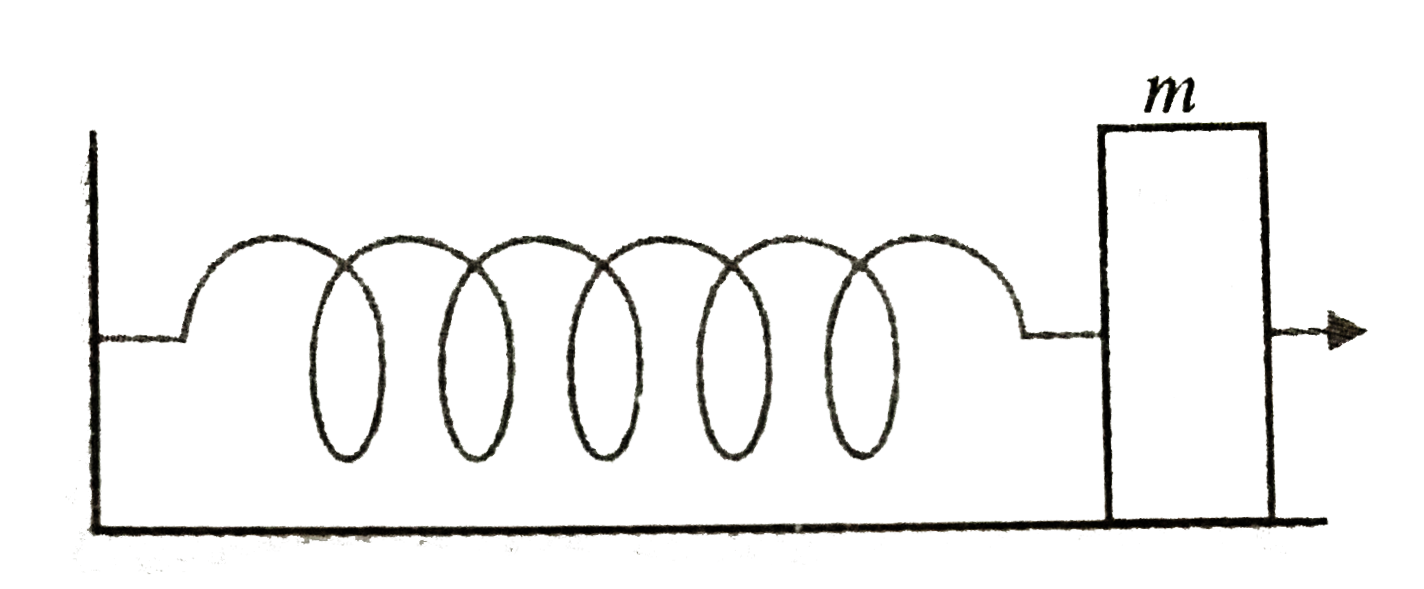Two rigid bodies A and B of masses 1 kg and 2 kg respectively are rigidly connected to a spring of force constant 400 . The body B rests on a horizontal table. From the rest position , the body A is compressed by 2 cm and then released . Deduce (i) teh frequency of oscillation, (ii) total oscillation energy, (iii) the amplitude of the harmonic vibration of the reaction of the table on body B.

Since it is body A which is oscillation , m=1 kg
(i) Frequency of osillation ,
or
(ii) Total oscillation energy,
or
Total force acting on the table
This is the mean upward reaction. Now, due to oscillation, the maximum tension developed in the spring is given by
Thus , the amplitude of the vibration of reaction of the table will vary from (29.4+8) N to (29.4)N.
Similar Questions
A body of mass 16 kg is made to oscillate on a spring of force constant 100Nkg−1. Deduce the angular frequency.
View SolutionA 2.5 kg collar attached to a spring of foce constant 1000 Nm−1 slides without friction on a horizontal rod. The collar is displaced from its equilibrium position by 5.0 cm and released. Calculate (i) the period of oscillation (ii) the maximum speed of the collar and (iii) the maximum acceleration of the collar.
View Solution
Knowledge Check
Two blocks A and B of masses 5kg and 2kg respectively connected by a spring of force constant =100Nm−1 are placed on an inclined plane of inclined 30∘ as shown in figure If the system is released from rest
 AThere will be no compression or elongation in the spring if all surface are smoothBThere will be no compression or elongation in the spring if A is rough and B is smoothCMaximum elongation in the spring 35cm If alll surface are smoothDThere will be no compression or elongation in the spring if A is smooth and B is rough
AThere will be no compression or elongation in the spring if all surface are smoothBThere will be no compression or elongation in the spring if A is rough and B is smoothCMaximum elongation in the spring 35cm If alll surface are smoothDThere will be no compression or elongation in the spring if A is smooth and B is roughIf a body of mass 0.98 kg is made to oscillate on a spring of force constant 4.84 N/m the angular frequency of the body is
A1.22 rad/sB2.22 rad/sC3.22 rad/sD4.22 rad/sSpring of spring constant 1200Nm−1 is mounted on a smooth fricationless surface and attached to a block of mass 3kg. Block is pulled 2cm to the right and released. The angular frequency of oscillation is
_S01_037_Q01.png) A5rad/secB30rad/secC10rad/secD20rad/sec
A5rad/secB30rad/secC10rad/secD20rad/sec
A body of mass 0.5 kg is suspended by a weightless spring of force constant 500 Nm−1. Another body of mass 0.1 kg moving vertically upwards with velocity of 5 ms−1 hits the suspended body and gets embeded into the suspended body. What will be the frequency of oscillation ?
View SolutionTwo bodies with masses m1 = 1kg and m2= 2kg are connected by a spring of force constant k=24Nm−1. The left ball is imparted an initial velocity v0=12 cm/s. Find (a) the frequency of the oscillations (b) the energy and the amplitude of the osciallations.

View SolutionA spring of force constant 1200Nm−1 is mounted on a horizontal table as shown in figure. A mass of 3.0kg is attached to the free end of the spring, pulled side ways to a distance of 2.0cm and released. Determing.
(a) the frequency of oscillation of the mass.
(b) the maximum acceleration of the mass.
(c) the maximum speed of the mass.

View SolutionTwo bodies of masses 1 kg and 3 kg respectively are connected rigidly by a vertcal spring. The body of mass 3 kg rests on a smototh horizontal surface. The force constant of the spring is 484Nm−1. From the equilibrium position, the mass of 1 kg is displaced vertically through a distance of 0.02 m and then released. calculate (i) and frequency of oscillation of the mass of 1 kg (ii) the maximum velocity of this mass (iii) its oscillation energy and (iv) the reaction of the table on the mass of 3 kg, when mass 1 kg is having harmonic oscillations.

View SolutionA spring of force constant 600Nm−1 is mounted on a horizontal table. A mass of 1.5 kg is attached to the free end of the spring, pulled sideways to a distance of 2 cm and released .P.E. of the mass when it momentarily comes to rest and total energy are
View Solution
